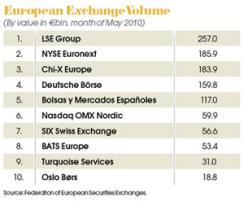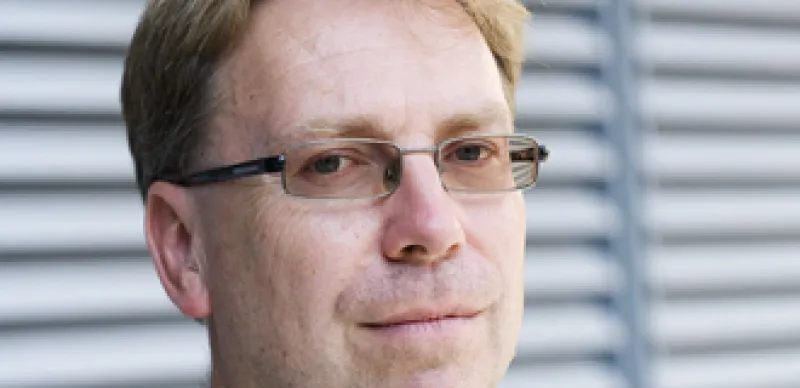On his morning walk to his office in the City of London, Alasdair Haynes, chief executive of the alternative-equity-trading operator Chi-X Europe, often spots David Lester, the recently appointed CEO of competitor Turquoise Services. Usually, their paths cross at about 7:30 a.m. opposite the HMS Belfast, the World War II battleship that’s moored on the River Thames. Having known each other professionally for years, the two men take the time to stop, shake hands and “compare market share,” says Lester. Explains Haynes, “We are convinced that tongues would wag if we were ever caught having coffee together, but we do like to have a chat.”
As soon as the morning’s pleasantries are over, however, the two men go to their respective offices for another day’s pitched battle in the fiercely competitive market for pan-European equity trading. Increasingly, it’s a contest that Haynes is winning.
Chi-X is at the forefront of a revolution sweeping Europe: Upstart electronic exchanges known as multilateral trading facilities, or MTFs, are taking on — and often beating — once-dominant national stock exchanges. In a process similar to the upheaval seen in the U.S. over the past decade, the MTFs are taking advantage of regulatory liberalization to seize business by offering lightning-fast, low-cost trading capabilities. Their youth is an asset, not a liability. Unburdened by the costs and outdated legacy trading platforms of many centuries-old exchanges, the MTFs are applying the latest technology to service the needs of major securities firms — many of which own equity stakes in the new exchanges — as well as those of the fast-growing community of high frequency trading firms.
The results are striking. Barely three years after launching its service in March 2007, Chi-X operates in 15 national markets and has become Europe’s third-largest equity-trading platform by trade value, according to data from the Federation of European Securities Exchanges (see table, right). The company handled equity trades worth €183.9 billion ($224.2 billion) in May, ahead of Deutsche Börse (€159.8 billion) and trailing only NYSE Euronext (€185.9 billion) and the LSE (€257 billion). BATS Europe, a division of U.S.-based BATS Global Markets, and Turquoise, which the LSE acquired in February, also have fought their way into the top ten.
“For the first time, the established exchanges have faced real external competition,” says John Woodman, chairman of Chi-X Europe and a member of the Regulatory Decisions Committee of the U.K.’s Financial Services Authority. The rise of the MTFs “has challenged them in their core product area — crossing orders — and that has had a very significant effect on prices, exchange margins and volume growth.”
As a new player needing to build liquidity from scratch, Chi-X was the first in Europe to adopt the so-called maker-taker pricing system pioneered by alternative exchanges in the U.S. The company offers rebate fees (currently 0.20 basis points) to customers that “make” liquidity by supplying bid-offer quotes to the trading book and charges a low “take” fee (0.30 basis points) to clients who remove liquidity by hitting those bids and offers. Most European exchange executives initially doubted that such a pricing model could be sustained, but Chi-X has proven the skeptics wrong. The company, which as a private entity doesn’t publish results, asserts that it has turned a profit every month this year.
“The business model does work,” says Haynes. “We’re comfortable with what we charge and see no reason why we can’t continue to build market share, gain greater profitability and put enormous pressure on those businesses that are charging considerably more.”
The company’s ownership structure has also helped foster its growth. Founded as a wholly owned subsidiary of agency brokerage Instinet Europe, an arm of Japan’s Nomura Holdings, Chi-X has periodically offered equity as a reward to its biggest customers in a bid to encourage their business. Today, Chi-X is owned by a consortium that includes Instinet Holdings (with a stake of 34 percent) and 18 other financial institutions, including hedge fund firm Citadel, high frequency trading shop Getco and investment banks Goldman Sachs Group and Morgan Stanley.
There’s no small irony in that consortium approach, which harks back to the industry’s traditional structure. Europe’s national exchanges operated for decades as mutuals owned by each country’s leading banks and brokerages before Germany’s Deutsche Börse, Euronext and the LSE went public in 2001. The exchanges believed that listings would give them the currency to pursue pan-European consolidation, but numerous merger attempts failed. Instead, the now-profit-minded exchanges looked to maximize their trading revenues, angering many of the banks and brokerages that were their biggest users.
In a fresh bid to bring down Europe’s high trading costs and foster a pan-European market, the European Union introduced the Markets in Financial Instruments Directive, or MiFID, in November 2007. The sweeping regulatory reform abolished concentration rules that for many countries had required trading to go through one central exchange, and directed brokerages to provide best execution services to their clients. By launching its service in March 2007, ahead of MiFID and fully 18 months before other MTFs opened, Chi-X gained an early advantage over its rivals — one it has extended significantly.
Today the company is a force to be reckoned with in European blue-chip stocks. In May, Chi-X handled almost 29 percent of the trading volume in the constituent stocks of London’s FTSE 100 index, according to data from Thomson Reuters Equity Market Share Reporter; the LSE’s share stood at nearly 54 percent, down from 68 percent in May 2009 and 84 percent two years earlier. Chi-X has also made big inroads on the Continent. In May the company handled 21 percent of the volume of stocks in France’s CAC 40 index, up from 17 percent in May 2009, and 20 percent of the trading of stocks in Germany’s DAX 30, up from 15 percent in May 2009, according to Thomson Reuters. The incumbents seem destined to suffer the fate of their U.S. counterparts, the New York Stock Exchange and the Nasdaq Stock Market, which today control less than half of the trading in the shares listed on their markets.
With its equity presence firmly established, Chi-X is now looking to broaden its assault. Haynes, who took over as CEO in January, plans to go head-to-head with the incumbents across the breadth of their activities, including data services and derivatives. “We are in a very strong position today, but we have to continue to build and innovate,” says Haynes. “We’re doing this much business with a staff of 40-odd people, which just proves how good technology and processes have allowed us to create a very robust, solid, high-integrity marketplace.”
The rise of Chi-X and other MTFs is prompting the established players to fight back. In February the LSE acquired a 60 percent stake in London-based Turquoise, which was created by a consortium of nine global banks in September 2008 with the specific aim of undermining the LSE’s high trading fees. (Since then, the LSE has reduced its stake to 51 percent by bringing in Barclays, J.P. Morgan Cazenove and Nomura as shareholders.) The deal gives the LSE access to Turquoise’s volume: as of late June, roughly 7.5 percent of FTSE 100 stocks, 3.8 percent of the CAC 40 and 3.2 percent of the DAX 30. More importantly, the acquisition strengthens the LSE’s ties with some of the biggest sell-side equity traders in London and gives it a pan-European platform for competing on the Continent. In a sign of banks’ determination to spur more-competitive pricing, Turquoise and Chi-X have several shareholders in common: Bank of America Merrill Lynch, BNP Paribas, Citigroup, Credit Suisse, Goldman Sachs, Morgan Stanley, Société Générale and UBS.
“The LSE is now moving more toward a dual-market structure that we’ve seen in the U.S.,” says Justin Schack, a market-structure analyst at New York–based Rosenblatt Securities. “They have a sell-side-friendly platform in the main exchange, and they are trying to make Turquoise into their high-frequency-friendly platform.”

Haynes thinks the LSE’s strategy is cannier. “The LSE, through the purchase of Turquoise, is now taking on the MTFs in their own game — which is exciting for all of us and good for the industry,” he says. “The other national exchanges are, in many ways, only building larger national walls to try and prevent anything from happening. But wall building only delays the inevitable. We’re not going away.”
Silver-tongued and gregarious, the 50-year-old Haynes may be new to Chi-X, but he is an exchange industry veteran who has pioneered major changes in the European markets. A former global head of equity derivatives at HSBC James Capel, he joined Investment Technology Group as CEO of its new European subsidiary in 1997 and introduced its Posit system as Europe’s first electronic crossing network, or dark pool, which allowed the matching of large institutional blocks of shares. From 2006 to 2009 he was CEO of ITG International, running all of the New York–based company’s non–North American business.
For most of 2009, though, Haynes found himself on the sidelines, having left ITG to recover from major back surgery. During his recuperation, he says, he played “some appalling golf” and waited to see what the market would bring in the way of new opportunities. “I always said that I would come back to the City of London when I found something that I absolutely wanted to do,” he says. “When I was approached about the job at Chi-X, I was intrigued. Running Chi-X sounded incredibly exciting.”
For its part, Chi-X was looking for a seasoned executive following the departure of co-founder and CEO Peter Randall in February 2009. “Alasdair brings clear management abilities and a keen awareness of the importance of technology to support all aspects of trading,” says Woodman. “It has been a linchpin of his career.”
Technology and interoperability are at the heart of Chi-X’s success. The company’s system offers round-trip trade execution in 400 microseconds — roughly half the time of Turquoise’s median speed — for clients that colocate servers with the exchange.
In May 2009 the company introduced a new dark pool, Chi-Delta, for institutions seeking to protect their block trades from the prying eyes of other market participants — namely, high frequency trading firms. Chi-Delta now regularly ranks as the largest publicly declared dark pool in Europe by value traded. According to Thomson Reuters, Chi-Delta controlled 32.13 percent of all reported European dark liquidity in the first quarter of 2010, well ahead of Liquidnet Europe (19.42 percent), Turquoise (13.22 percent) and ITG Posit Europe (10.27 percent).
Cost reduction — particularly in trade clearing, which has so far been insulated from the effects of MiFID — holds the key to further growth. Deutsche Börse owns its clearing arm and generates a large share of its profits from the business; NYSE Euronext is in the process of setting up clearing facilities in the U.S., U.K. and France that may help it control costs. The LSE, much to its frustration, relies mainly on LCH.Clearnet Group and has little control over clearing costs. Last year the exchange’s CEO, Xavier Rolet, asserted that even if the LSE eliminated its trading fees, the total cost of transacting on the exchange’s main market would still be about 3.5 times higher than that of using any rival MTF because its clearing costs, including netting and settlement, are so high. The MTFs, by contrast, have benefited from the creation of the European Multilateral Clearing Facility, or EMCF, a pan-European clearer established in March 2007 to introduce competitive clearing services for the MTF market. EMCF, which is owned by Fortis Bank Nederland and Nasdaq OMX Nordic Group, provides central counterparty clearing services for eight MTFs and exchanges across 18 European markets, including Chi-X. Turquoise clears its trades through London-based European Central Counterparty, a subsidiary of U.S.-based Depository Trust & Clearing Corp.
Haynes is eager for Chi-X to capitalize on its independence by offering central clearing party interoperability as soon as regulators permit it. Earlier this year the company was poised to provide clients a choice among LCH.Clearnet, EMCF and Zurich-based SIX Swiss Exchange’s SIX x-clear, but regulators have suspended moves toward interoperability because of concerns about potential counterparty risks, forcing Chi-X to put its plans on hold.
Having won a big share of European equity trading, Haynes is looking to eat into other lucrative areas of the incumbent operators’ businesses, beginning with data. The potential is significant. The LSE, for example, raked in £169.3 million ($255.6 million) from real-time data and other information services in the year ended March 31, or 27.9 percent of its total revenues of £605.6 million. To Haynes, those fees represent a lingering monopolistic stranglehold.
“I have nothing against people charging for value-added data, such as index data,” he says. “But charging someone going into the market for a simple bid-offer spread? I believe that data should absolutely be free because it helps the marketplace decide where the market actually is.”
Chi-X has always provided so-called Level 1 data, or best bid-and-offer prices, to its clients for free. The company’s Level 2 data, which encompasses tick-specific information from the entire order book, wasn’t very meaningful initially, but it has become increasingly valuable as Chi-X’s market share has grown, and Haynes would like to monetize it at some point.
The bigger opportunity, though, lies in greater transparency, Haynes believes. The Committee of European Securities Regulators is conducting a review of MiFID this summer, and Haynes, like many others in the industry, expects that the regulatory body will mandate a consolidated tape to show the best prices from all exchanges and MTFs. If Europe follows the U.S. model, where exchanges share the profits of the consolidated tape’s distribution, then MTFs like Chi-X would stand to earn a percentage based on their market shares.
The greater transparency that a consolidated tape would provide could also be a boon to low-cost operators like Chi-X. “Market data is going to become more consolidated and aggregated across Europe, which will make it increasingly obvious where the best price is and where liquidity is concentrating,” says Miranda Mizen, a principal at New York–based research firm TABB Group. “That information in turn will make it much easier for firms to know where they need to connect.”
Providing data can be fraught with unexpected pitfalls, however, as Chi-X recently experienced. In May a report by Chatham, New Jersey–based agency brokerage Themis Trading identified weaknesses in data protection at several U.S. exchanges, namely BATS’s direct-feed BATS Pitch and the Nasdaq direct feed known as TotalView-ITCH. The report alleged that the data services were revealing dark-pool trade information such as customer identification numbers and cumulative executions of hidden orders. High frequency traders could take advantage of such data to determine customers’ positions, it said.
Although Chi-X was not named in the report, any exchange that provided a direct data-feed interface was assumed to be vulnerable. Customers of Chi-X reacted quickly. In the nine days after Themis published its report, the value of trades on Chi-Delta, Chi-X’s dark pool, plunged by nearly 60 percent, to €109.1 million, according to Thomson Reuters. Haynes responded with alacrity. Chi-Delta no longer discloses any posttrade data that might reveal information about customer orders. BATS Europe has taken similar action. Turquoise, under Lester’s guidance, announced that it had already taken steps to make its dark pool safer and did not release trade information.
Client nervousness about the protection of information is nothing new for Chi-X. Despite — or perhaps because of — its diverse group of equity owners, which include Getco and Citadel, Chi-X has long inspired a certain caution among some buy-side firms. But its customer base is virtually analogous to those of the large incumbents. Currently, Haynes says, the MTF has 126 clients. Approximately 40 percent of trading comes from clients that “need a very low-latency environment,” mostly high frequency trading firms, says Haynes; the balance is done by banks, brokerage houses, agencies and the like. The LSE doesn’t disclose its high frequency business but does say that clients that colocate servers with the exchange are generating nearly 20 percent of daily volume.
As European equity trade flows become faster and more heavily commoditized, Chi-X is looking to add other asset classes to its lineup — and the huge market for trading equity-index-based derivatives is at the top of Haynes’s target list. The CEO lobbied hard to get Chi-X’s prices included in the calculations of the major indexes, like the FTSE 100, as a precursor to launching derivatives based on the indexes, but the established exchanges have been reluctant to integrate Chi-X’s data. Haynes is now turning his attention to the possibility of Chi-X creating its own indexes, which would allow it to offer exchange-traded funds, futures and options. “That is the dream,” he says. “We are a long way from achieving that dream, but I know that is the direction that we’re going to go.”
Such a strategy makes sense. The LSE, which has an admittedly weak derivatives business, nonetheless generated £19.5 million in derivatives revenue in the financial year ended March 31. Deutsche Börse gets nearly 40 percent of its revenues from its Eurex derivatives trading and clearing platform.
In the meantime, a whole series of strategic skirmishes remain to be fought in the shadow of the HMS Belfast. In April, Turquoise was the first MTF to expand its trading services to U.S. securities, thanks in part to the relationship between EuroCCP and DTCC. Chi-X has yet to respond, but Haynes is not one to ignore a competitive thrust. For as long as he and David Lester keep meeting on their morning walks to work, they will keep trying to find ways to outthink each other.






